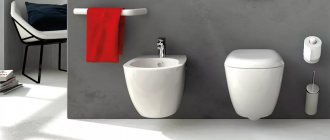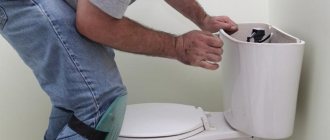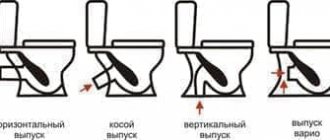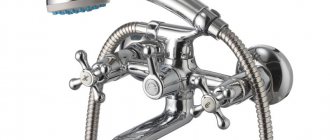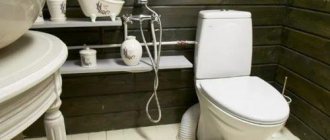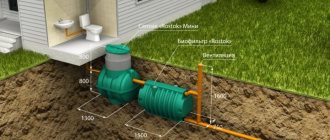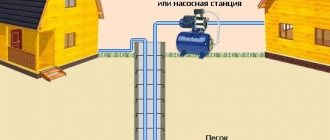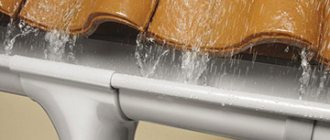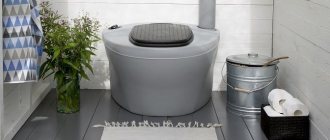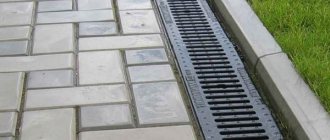It would seem that what is difficult in choosing plumbing equipment? After checking the contents and quality of the product, you can safely proceed with its installation. But life experience and recommendations from experts tell a different story - mistakes when purchasing among all the variety can lead to sad results, and not only of a technical nature. This qualified knowledge is needed not only for those who have just completed construction - it can be fully used by people who have started repairing and replacing all components in the bathroom.
Modern manufacturers are ready to offer specimens that differ in at least a dozen criteria. Therefore, knowing which toilet flushes well or how best to secure the device means making an informed choice and protecting yourself from unforeseen problems. Let's look at the main parameters of plumbing fixtures on the current market.
Exhaust system in the toilet: its varieties
When a buyer comes to buy a toilet, he first needs to decide how the outlet pipe of the product should be directed. The choice depends on how you laid (or are going to lay) the sewer pipe. There are three options:
- The pipe is laid on the floor in an open way: an option for those who care little about the subtleties of design. Here it is most widespread. In this case, you need to purchase a toilet with a pipe directed obliquely downward. It connects directly to the sewer pipe.
- The pipe is hidden in the space behind a gypsum plasterboard partition: with this design, the room is provided with a presentable appearance. In this case, the toilet must have an outlet pipe directed horizontally. It is connected to the socket by means of a piece of pipe (if the axes coincide), an eccentric collar (if the displacement is slight) or a corrugation (if the displacement is strong).
- The pipe is laid under the ceiling and led through a hole made in it directly to the toilet: the most successful solution from a design point of view - the pipe is not visible, and there is no need to fence off anything with a partition.
The third option is applicable only in private homes. With this arrangement of the sewer system, a toilet is installed with a pipe directed vertically downwards, which is connected to the socket via a flange or a plastic part - an oil seal.
What determines the presence of splashes? Choosing the shape of the bowl
It turns out that the presence or absence of splashes depends on the shape of the bowl. There are three types of toilet bowls:
- Disc-shaped. A traditional bowl shape that differs significantly from other types. Along the path of water from the tank there is a shelf, or a recess in the form of a plate. Human waste entering the toilet lingers on this ledge before entering the drain hole. A powerful drain forms a funnel, which causes splashes.
- Funnel-shaped. A design feature of the funnel-shaped bowl is the location of the drain hole. It is located in the very middle of the recess. All waste goes into the hole immediately, so there is no splashing and no need to use a brush.
- Kozyrkovaya. In this type of toilet, the drain is close to the front side of the product. Instead of the indentation present in the first point, there is a protrusion here. Most of the waste goes straight to the drain. The rest is washed off with a small pressure of water with a minimum amount of splashes.
Which flush system to choose?
Depending on the design of the toilet bowl, water can be supplied to it in two ways:
According to the cascade scheme
This is a classic option in which water simply flows down the back wall of the bowl.
The advantage of toilets with such a flush system is their low cost.
The disadvantage is that a significant part of the bowl is not washed with water, which means the user will have to wash the device more often.
In a circular pattern (shower type flush)
At the manufacturing stage, a channel is formed under the rim of the toilet, covering the entire bowl on both sides. When the drain mechanism is activated, water first rushes into this channel, and only then flows down from it. Thus, dirt is removed from the entire internal surface of the product.
Despite the fact that the rear wall is subjected to less intensive processing than with cascading water movement, this type of flush is considered more progressive.
But it has two disadvantages: high cost and fragility - when using low-quality water, narrow channels and holes in them quickly become clogged.
Suspended modification with installation
The word “installation” in this case should be understood as the word “hide” or “conceal”. When talking about installing a toilet, we are talking about the structure and fastening elements of the toilet built into the wall. This toilet significantly saves space in the bathroom and looks very stylish and neat. For a small room this is the best option.
Compared to conventional toilets, wall-hung toilets have significantly more advantages:
- Maintaining hygienic cleanliness in the bathroom with such models is much easier. There is no need to constantly clean the toilet mounting points, as well as various cracks between the floor and plumbing.
- If a heated floor or expensive floor covering is installed in the bathroom, then they will not be affected during plumbing repairs.
- Due to the fact that everything unnecessary is hidden in the wall (fasteners, tank), and only the drain button remains visible, it looks minimalist and stylish.
A wall-hung toilet also has its disadvantages:
- High price;
- If repairs are necessary, it will be difficult to get to the tank or pipeline valves hidden in the wall.
Toilet design features - which is best?
The quality of the flush is determined not only by the nature of the water movement, but also by how much the bowl gets dirty during use. And here a lot depends on its shape. Let's discuss the existing options.
Visor bowls
For a long time, this form of toilet was considered classic. From the inside, the bowl looks like a sloping slide with a convex surface, the drain hole (siphon) is located in the front part. Sewage falls right on that very slide, so such a bowl usually gets very dirty and the user has to clean it up with a brush.
Toilet bowl shapes
Funnel bowl
Wanting to make life easier for the user, manufacturers moved the drain hole directly under it, that is, almost to the center of the bowl. Now the impurities fall directly into the water and the cup remains unstained.
One could celebrate the victory, if not for an annoying circumstance: the user may be doused with a not-so-clean fountain.
If you decide to buy a funnel-shaped toilet, give preference to models with an anti-splash system. Here are their distinctive features:
- the vertical distance from the side to the water surface has been increased;
- The diameter of the drain hole is reduced.
The drain hole is equipped with a special rim.
The type of toilet outlet is selected depending on how the sewer pipe is laid. A toilet with a vertical outlet to the floor is not the most popular modification, but it has its advantages.
See instructions for assembling the toilet here. Materials and tools necessary for work.
Tiled flooring is the most common in bathrooms. Installing a toilet on tiles requires a careful approach. Using this link https://aquacomm.ru/cancliz/mnogokvartirnyie-doma/santehnika/montazh-na-kafel.html we will reveal all the nuances of installing a toilet on tiles.
Disc bowl
In such a toilet, instead of a sloping slide, there is a platform, which is also called a “shelf”, “step” or “springboard”, and the drain hole, as in the canopy structure, is moved forward. Devices of this type are especially popular in hospitals, as they allow visual monitoring of the condition of excrement or selecting it for analysis.
Most users consider this form outdated and extremely unsuccessful.
It is argued this way:
- while feces lie on the “step”, they manage to fill the room with an unpleasant odor;
- During flushing, the water, moving like a ski jumper, can splash the user.
Toilet with shelf
However, on the Internet you can find many positive reviews about toilets of this design. The authors of these messages draw the attention of readers to the following advantage: the bowl does not get dirty, since the sewage ends up in a small puddle on the “step”; in this case, no splashes are observed, as is the case with a funnel-shaped toilet.
As for splashes during flushing, to eliminate them you just need to adjust the drain. Fans of such toilets are extremely upset that they have become a rarity today, and refer everyone to the catalogs of the Russian sanitary ware manufacturer Santeri.
Raw material base
As with forms, there is now more freedom with materials than before, and although there are only two main ones - earthenware (sanitary ware) and porcelain (sanitary porcelain), there are other options on sale.
- Faience is ceramics with a finely porous structure, made from white clay, coated with white or colored glaze to reduce permeability. The main advantage of earthenware is its accessibility, but the enamel layer gradually wears away, which leads to a decrease in service life and characteristics. However, high-quality earthenware without coating defects and with careful use will last for 15-20 years.
- Porcelain is the same white clay, but with additives (quartz and feldspar), due to which the density is higher and the characteristics are higher than those of earthenware. Consequently, the service life is approximately twice as long, but given that the price is also almost twice as high, everyone decides for themselves whether the game is worth the candle.
- Stainless steel - such toilets are superior in strength and durability to both earthenware and porcelain, but due to their specific appearance they are used mainly in public places. But if the bathroom is in high-tech style, then this choice is completely justified.
- Marble is exclusive, made to order, hygienic and practical, visually for an amateur, for a very wealthy lover. As an option - made of artificial stone, it looks the same and costs less.
By and large, what is important is not so much the material, be it earthenware or porcelain, as the quality of workmanship, the integrity of the glaze layer and its presence not only in visible areas, but also on the inside of the flush hole.
Additional tips and advice
As the glaze coating wears away, the material of the bowl begins to play an increasingly important role in the quality of the flush.
Know that porous earthenware absorbs dirt much better than dense, almost glassy porcelain.
Also, those who want to get the best flush can be recommended to abandon the usual Compact model, in which the tank is installed on the bowl shelf.
It is better to purchase a separate version instead, which involves installing a tank under the ceiling. This will increase the water pressure in the bowl, and, accordingly, the quality of flushing.
What to do if water does not flow into the toilet tank? Possible malfunctions and solutions will be discussed in this topic.
The criteria for choosing a toilet with an overview of existing modifications are described in this article.
Accommodation
There are differences in plumbing models based on the type of installation, divided into three types.
Corner and classic models are available, placed next to the wall opposite the entrance. Both types are installed directly on the floor or on a stand. When secured with anchor bolts during installation, it is easy to dismantle the equipment, replacing old with new without causing damage to the floor covering.
Models with an attached skirt do not affect the functionality of the design. It is an aesthetic element created by designers. When doing wet cleaning, do not touch the plumbing equipment with the rag.
Corner floor
Installation is carried out in a standard way. The corner structure is distinguished by the shape of the barrel, which fits in the center of the junction of two wall panels.
Wall or hanging
During installation, a plate is used that is built into the side panel of the toilet. The work is done by professionals. The equipment is secured to the slab in the wall with anchors. Such models are in demand in Europe, but in our country they are rare.
Advantage:
- Easier to clean the toilet.
- Saving space.
- Stylish design
You need to purchase plumbing fixtures after you have become familiar with all types of drains, installation methods and functional features. Choosing the right toilet from quality material will make it easier to care for. Having set anti-splash as a criterion, they understand that the price for such a product is high. This will be affected by the shape of the bowl and the flushing device.
The shape of the splash-free toilet is the same for all models. It has an internal rim that holds back the flow of water leaving the barrel under pressure. If the seller talks a lot of interesting things about a special device in order to sell an expensive illiquid product, then this is not the main thing. It is advised to find plumbing equipment with a suitable bowl equipped with a protective barrier from the inside. Video: Features of choosing a wall-hung toilet
Only a properly selected toilet can be considered comfortable. The choice of new plumbing is influenced not only by convenience, appearance and price
It is important that the toilet fully copes with its main function - it flushes well and does not splash. How to choose just such a toilet?
Floor model
This type of toilet is the most common because it is easy to install. You literally need to screw a couple of screws to the floor and then fix the toilet with a cement solution. Any man can handle this. Also, such structures are usually small in size, and besides, their cost is an order of magnitude lower than suspended structures.
The disadvantages of such models are:
- difficulties in cleaning the bathroom;
- the difficulty of choosing a model from a wide variety;
- rather unaesthetic appearance.
Now on sale you can find models of toilets that combine the qualities of a floor-mounted and wall-hung toilet. The barrel of such plumbing is hidden in the wall, and the bowl itself is attached to the floor. This type of toilet is called a side-mounted toilet.
Advantages of attached modifications:
- All fasteners, valves and a drain tank are hidden in a niche and thus do not “eat up” the space in the room. It also looks very laconic.
- The bowl has a lid and convenient fasteners.
Disadvantages of attached modifications:
- Labor-intensive maintenance and repairs;
- Some inconveniences in maintaining the hygienic cleanliness of the bathroom.
